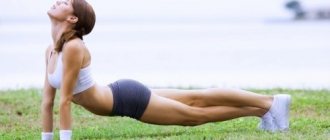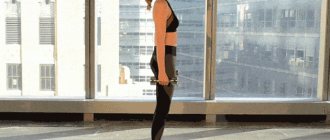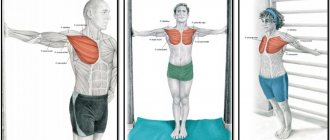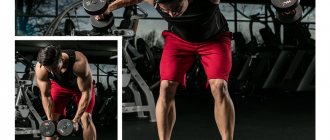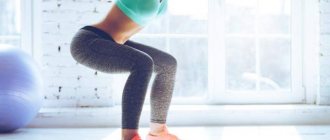The essence and basic principles of exercises
Why you need to warm up before every run:
- The work of the lungs and heart accelerates, which allows you to rebuild the body’s activity for further stress.
- Metabolism in the body accelerates, ensuring the flow of necessary hormones into the blood.
- The rate of breakdown of chemicals increases, giving the body energy for muscle contraction.
- Muscles and tendons become toned, joints are strengthened, thereby reducing the risk of injury.
- Warming up prevents acidification in the muscle fibers, which reduces the likelihood of muscle clogging.
Warm-up before running for beginners usually takes 15-20 minutes, this time is enough to adjust breathing, warm up all the muscles and comprehensively prepare the body for a run.
If you lack time, it is better to reduce the number of exercises and shorten the warm-up to 5-8 minutes, but you should not completely neglect the warm-up before jogging, so as not to increase the risk of sprains, tears and fractures.
The warm-up should begin with the upper parts of the body and end with the lower parts. It is best to first do general warm-up exercises in order to prepare the body for the load, and then running exercises in order to warm up the muscles and ligaments of the legs. All general warm-up exercises are done with a straight back and feet shoulder-width apart.
Warm-up before running for beginners includes exercises for all muscle groups involved in jogging , it is necessary to warm up not only the legs, but also the muscles of the arms, pelvis, back and neck, this will allow you to fully warm up the body and protect it as much as possible from possible injuries: the better warm-up, the safer and more effective the workout.
Mistake 1. Changing the angle of your elbow while moving
To do lateral raises correctly, you need to bend your elbows slightly and then maintain that angle throughout the entire approach. The angle of the elbow joints should be the same at the top and bottom of the range of motion, and nothing else!
If you start bending and extending your elbows, you bring your triceps into the equation and reduce the isolation of your middle delts that you crave. Ideally, when lifting a dumbbell, your arms should describe an arc, and not move in a straight line. Look at yourself in the mirror or have someone watch you as you raise your arms to the sides. This error is easy to fix; you just need to pay a little attention to this aspect.
Indications for use
Beginners should definitely warm up before running, so as not to damage ligaments and joints or clog muscles . Warm-up is also recommended for people with a sedentary lifestyle, as it helps keep the body in good shape and promotes slow aging.
Warming up will help warm up the body and prevent possible injuries during any activity. Running load helps improve the functioning of the respiratory system, stabilize the functioning of the heart and blood vessels.
General and running warm-up exercises will help:
- improved breathing;
- increasing the oxygen capacity of the blood;
- decreased shortness of breath during any physical activity;
- strengthening the musculoskeletal system;
- hardening of the body;
A set of exercises for men
| Exercises | Approaches | Number of repetitions or duration |
| boat | 3 | 10-20 |
| Wide push-ups | 3 | 10-20 |
| Upper press lying on your back | 3 | 15-25 |
| Lower abs - twisting with body rotation and leg bending | 3 | 15-25 |
| Wide stance squats | 3 | 15-25 |
| Oblique press – Mill | 3 | 15-25 |
Be sure to check out:
Workout 12 – Anti-quarantine marathon Workout 11 – Anti-quarantine marathon Workout 10 – Anti-quarantine marathon Workout 9 – Anti-quarantine marathon
Contraindications for use
Running and running exercises are contraindicated for people with problems with the heart and blood circulation , but general warm-up exercises can be performed with restrictions, in a relaxed mode: do not strain or make breathing difficult. If your heart rate increases, you need to stop and take a few deep breaths.
People with spinal problems should not do forward bends with stretching, circular movements or body bends. If there are problems with the cervical vertebrae, then it is not recommended to help with your hands when tilting your head.
When performing running exercises, you need to pay attention to fatigue in the hips, knees and ankles. If you feel severe tension or pain, you need to stop working and contact a traumatologist to identify problems with the joints.
Lower thoracic spine
1. Tilts, forward and backward. We work sitting on a chair or on the floor. We hold the seat of the chair with our hands, our back is vertical. We begin to bend as we exhale, trying to bury our nose in our own navel; as we inhale, our back straightens. We spend 5-6 seconds on each movement. We do 10-15 movements without serious effort. When bending backwards, the spine moves forward. We try to reach the buttocks with the back of the head. 2 times 10-15 movements.
2. "Bow". The fists rested on the back - in the area of the kidneys. We try to bring our elbows as close as possible, imagining that our fists are sinking deeper into the body. The spine arches like a bow (fists - arrows). In other words, the position looks like you are about to make a bridge. In this position, we try to bend the spine a little more. Reverse movement. We begin to “slouch”, bending the lower thoracic spine in the opposite direction. Having reached the limit, we try to bend a little more.
3. "Big scales." The left hand is on the back of the head, the right hand is along the body. In this position, we bend to the right, then in the same way to the left, each time making additional efforts.
4. Twists. We fix the pelvis and hands on the shoulders. From this position we begin twisting. We move our eyes in any direction (as if trying to see what is behind us), then we turn our head, then the shoulder girdle. The amplitude of the twists is small, but each movement seems to slightly increase the angle of rotation.
Useful tips
For general warm-up exercises before running, you will need a small space to avoid bumping into foreign objects while doing the exercises. For running exercises, you will need a space of 30 m long; a treadmill in a stadium or a path in a park is perfect.
It is not recommended to do jogging and running exercises on asphalt because running on hard surfaces is harmful to your legs and back. To reduce the load on the knees and spine, it is recommended to use stadiums with rubber tracks or park areas with soft ground.
You should pay attention to the state of the body during warm-up exercises and jogging; if you feel very tired, it would be best to take a break.
To rest from exercise, you do not need to immediately stop or sit down, so as not to dramatically overload your heart. It is necessary to take a break during intense walking, gradually reducing the speed of movement.
It is recommended to warm up after five minutes. light jogging to adjust your breathing and stretch your feet well. There is no need to run fast before warming up, so as not to lose your breath and get injured.
It is best to prepare step by step:
- Run at a slow pace for 5 – 7 minutes.
- General warm-up exercises.
- Running warm-up exercises.
- Run.
Mistake 5. Fully extending your elbows
From time to time I see someone doing lateral raises with their arms fully extended at the elbows. At the top point, it looks as if a person is trying to depict the letter T. Full extension creates a colossal load on the elbow joints. No matter what exercise you do, permanently locking a joint is a bad idea.
Main complex
Basic warm-up exercises should begin with the neck, arms and shoulder girdle and end with knee joints, feet and stretching in order to proceed to running exercises with the ligaments and muscles of the legs fully warmed up.
The transition to running exercises necessarily requires stretching your legs as much as possible in order to strengthen their muscles, adjust your breathing, and not get injured. For convenience, the exercises are described in the order in which they are best performed, from top to bottom.
Head rotation
It is necessary to relax and lower your hands or place them on your belt. Next, you need to make slow, rotational movements with your head, 1 turn clockwise, 1 turn counterclockwise. It is necessary to repeat 3 - 5 revolutions in each direction. You need to rotate your head smoothly so as not to stretch the thin muscles and ligaments of the neck.
Head tilts in different directions
It is necessary to tilt your head 1 time to the right shoulder, 1 time to the left shoulder and repeat 3 times, the next 4 - 5 tilts you need to use your hands: slightly increase the strength of each tilt with your hand.
There is no need to put too much pressure on your head to avoid damaging the scalene muscles of the neck.
Head tilts forward and backward
The head bends down as much as possible and presses against the chest; it is necessary to stay in this position for 3 - 4 seconds. You should feel a stretch in the back muscles of the neck. Then you need to smoothly raise your head, throw it back and hold for 3 - 4 seconds. If you have difficulty breathing, you can open your mouth slightly. Should be repeated 3-4 times.
Circular movements in the elbow joint
You need to stretch your arms forward and perform 4 rotations in your forearms towards yourself and 4 rotations away from you. This should be repeated 3 times, but if you feel that the elbow joints are not stretched enough, you can increase the number of repetitions to 5-6 times.
Circular movements in the shoulder joint
The arms are completely relaxed and lowered down. Without straining your arms, you need to simultaneously perform 4 forward and 4 backward rotations with both shoulders, then perform 4 more forward and backward rotations with each shoulder separately. Then you should strongly stretch your arms down and perform 4 sharp rotations with your arms in a circle back and forth.
Rotations can be done with both hands at once or with each hand alternately. The hand should make a full circle with a large amplitude in order to stretch the shoulder joint, shoulder blades and pectoral muscles at the same time.
Hand jerks from the chest
Arm snatches are a must-have exercise for any warm-up, as they help to simultaneously warm up your shoulders, shoulder blades, chest and elbows. It is necessary to clench your hands into a fist, bend your arms to your chest, connecting your fists and raising your elbows. Next, you should perform 2 jerks simultaneously with both hands in different directions, without straightening your elbows, and 2 jerks with straightening your elbows. You need to repeat 4 times.
Jerking your arms up and down
One arm is extended upward, the second arm is extended downward, the hands can be gathered into a fist. Then you need to perform 2 sharp jerks back and quickly swap your hands, performing 2 more jerks. Repeat 4-6 times.
Tilts of the body in different directions
One hand should be placed on the belt or lowered down and relaxed, and the other extended up. It is necessary to perform 2 bends towards the free hand, then change hands and perform 2 bends in the other direction. The arm on top must be fully extended and not bent at the elbow joint when bending. For this exercise, you can also hold two straight arms above your head.
Body rotation
The arms are bent to the chest with the elbows down, the body is tilted forward. You need to perform circular movements with your body, each time returning to the forward fold position: 1 time clockwise, 1 time counterclockwise. You need to repeat these movements 4-5 times. When performing rotations, do not bend your legs.
Circular movements of the pelvis
Hands are placed on the belt, legs are shoulder-width apart and not bent. It is necessary to make 4 smooth rotational movements of the pelvis clockwise, maintaining posture and maintaining maximum amplitude, then 4 movements counterclockwise.
You need to repeat the movements 2-3 times.
Leg exercises
Warm-up before running for beginners necessarily includes exercises to warm up the knee and ankle joints and ligaments, as well as the calf and thigh muscles, this also includes stretching exercises.
You should pay special attention to warming up your legs: you should work through all the exercises as much as possible in order to achieve the best readiness of your legs for the load, since the legs account for 90% of all injuries when running.
Rotations in the knee joint
It is necessary to bend your knees at an angle of 30 - 40 °, place your hands on your kneecaps. Next, slow rotational movements are performed in the knee joint: each time during rotation, the knees are fully extended and bent again. It is necessary to repeat 8 - 10 revolutions in each direction.
Forward bends with stretching
This exercise is a leg warm-up, since its main effect is aimed at stretching the knee joints. The secondary effect of the exercise helps to warm up the muscles of the back and neck. You can leave your feet shoulder-width apart or, if you have poor stretching, place them a little wider. As your stretching improves, you can gradually narrow the distance between your legs until you are completely connected.
It is necessary to lean forward, touching the floor with your fingers and stay in this position for 2 - 3 seconds, or perform springy movements with a jerk up and down, each time increasing the strength of the tilt. Should be repeated 2 - 3 times.
Leg raises with hip rotation
You need to stand on one leg, bending your free knee in front of you. Perform 5 circular movements back and forth, each time returning the knee to its original position. Next, you should change your leg and repeat the same movements.
Lunges right and left
It is necessary to focus on one leg, sit on it, placing the second on the heel in the opposite direction. The free leg should be completely straight. Next, you should make a smooth roll on your free leg and stay in this position for 2 - 3 seconds. You need to repeat 4 times on each leg.
Your arms can be pulled forward into a lock or behind your head. It is best to tear off the heel of the supporting leg by placing emphasis on the toe.
Forward lunges with jumping changes of legs
It is necessary to focus forward on the right leg, placing the left straight back on the toe, and place the hands on the knee of the supporting leg. From this position, 4 springy movements are made. On the fourth lift, you need to jump, swapping your legs, and do the same movements for the other supporting leg. This should be repeated 3-4 times.
Rotations at the ankle joint
One of the legs stands completely on the foot, the second leg is placed on the toe. It is necessary to perform 5 rotational movements in each direction with the foot that is on the toe, then change the leg and perform 5 of the same movements.
Heel-to-toe raises
The legs are placed together so that the feet are pressed against each other. From this position, you need to lift up onto your toes, then roll up onto your heels. You should do 10 such movements.
Running exercises
Warming up before running includes running exercises that strengthen all the leg muscles and prepare them for the upcoming load . For beginners, such exercises are most useful, as they speed up the work of the lungs, adjusting breathing and normalizing the heartbeat.
Running exercises must be included in the pre-run warm-up complex for both beginners and experienced athletes.
Running exercises require space as they are not done on the spot. A treadmill, a path in a park, or a gym is best. It is recommended to do 2 series of running exercises, each of which is 30 m. Between series you need to normalize your breathing: walk 50 m at a slow pace, taking deep breaths and exhalations.
Running with high hips
You need to run, raising your knees to your chest with each step. Steps should be as frequent and small as possible. It is best to bend your arms and swing them along the body towards the opposite leg during the exercise.
Running with shin splints
Run with frequent small steps, during which you need to bend your free leg back, lightly touching your gluteal muscles with your heels.
Jumps
You need to jump on your supporting leg, land and change legs with a long step forward. Your arms should be bent and worked along the body.
Multi-jumps
Multi-jump is a run in which instead of steps, long jumps are made on the opposite leg. The front leg should be bent at the knee, and the back leg should be straightened.
The foot of the front leg should be pressed towards you, and the foot of the back leg should be extended. It is best to work along the body with bent arms: the right leg and left arm go forward and vice versa.
Added steps
Hands should be placed on the belt and stand sideways in the direction of movement. From this position, you need to take a side step, jump and land on the other leg. You should perform one series with each side and one series with a change: every second jump, change the side and the leading leg.
Week schedule
| Monday | Tuesday | Wednesday | Thursday | Friday | Saturday | Sunday |
| beginners | Easy jogging for 5 minutes, basic warm-up exercises, running at an average pace for 15 minutes. | Easy running 7 minutes, general warm-up exercises, running warm-up exercises, running at an average pace 20 minutes. | Easy jogging 7 min., general exercises, running exercises, running at an accelerated pace 25 min. | |||
| After two weeks of running | Easy jogging for 5 minutes, basic exercises, running exercises, running at an average pace with acceleration for 20 minutes. | 5 minutes. jogging, general exercises, running exercises, running at an average pace for 25 minutes. | Easy running 7 minutes, general warm-up exercises, running warm-up, running at an accelerated pace 25 minutes. | |||
| After two months of running | Light jogging for 5 minutes, general warm-up exercises, running exercises, running at an average pace for 20 minutes. | Easy jogging 7 minutes, general warm-up exercises, running exercises, running at an average pace 30 minutes. | Easy jogging 7 minutes, general warm-up exercises, running exercises, running at an accelerated pace 20 minutes. | 7 min., jogging, general exercises, running warm-up, running at an average pace for 25 min. |
Empty fields in the table indicate a day of rest.
Cervical spine
1. “Cleaning feathers.” The chin slides down, touching the chest. The head follows the chin. The neck is somewhat tense. The bird cleans its feathers.
2. Tilt the head to the right and left with fixation of the shoulders. The spine from the tailbone to the back is constantly straight. The movements are smooth, the shoulders are absolutely motionless. We tilt our head and, without much effort, try to touch our ear to our shoulder (10-15 movements in each direction).
3. "Owl". The head is placed level (in the same plane as the back). Slowly we move our gaze to the right or left and turn our head behind it (all the way, as if trying to see what is going on behind us). Each time, try to gain a millimeter or two, but without much effort, not forgetting that you are not an owl after all. We make 10-15 movements in each direction.
4. "Pumpkin". Circular movements of the head. The neck serves as the tail of the pumpkin. The pumpkin head rolls over the shoulders. Without overexertion, but with sufficient effort from the neck muscles, we perform the mastered elements sequentially. “We clean the feathers”, we reach the shoulder with our ear, “turtle” - the chin touched the chest, aiming for the coveted navel, then we move to the other shoulder, touch it with the ear, then the back of the head went to the back - we pulled the head in as if into a shell - and moved to the next shoulder.
Consolidate the result
In addition to warm-up exercises and jogging, beginners are advised to follow the correct diet : 1300 kcal per day when losing weight, 1700 kcal per day when maintaining weight, 2000 kcal per day when gaining weight.
When jogging regularly, it is necessary to maintain the correct sleep schedule so that the body is completely rested; it needs at least 7 hours of sleep a day. If the sleep schedule is not followed, the body becomes especially susceptible to diseases, the risk of viral and bacterial infection through airborne droplets increases, and excessive fatigue and soreness may occur.
Complex for women
| Exercises | Approaches | Number of repetitions or duration |
| Jumping with clapping | 3 | 15-30 |
| Lunges back and forth on one leg | 3 | 5-15 |
| Circular movements of the arms forward and backward | 4 | 20 |
| Wide stance squats | 3 | 10-25 |
| Upper press lying on your back | 3 | 15-25 |
| Lower abs - twisting with body rotation and leg bending | 3 | 15-25 |
| Jumping with clapping | 4 | 20-40 |
We hope you felt your body and had a great workout!
We are waiting for you on Wednesday, April 15 , at a new training session from Nikolai Mumrenko.
All training can be found on the main page of our Anti-Quarantine Marathon.
To receive notifications about new workouts, subscribe to our Telegram channel @gerculesfit.
When to expect an effect
By warming up and jogging according to a schedule, you can count on training results in just 3 weeks. If you run 1 - 2 times a week, you can expect results in 1.5 - 2 months.
Warm-up before running for professional athletes differs from warm-up for beginners only in the number of exercises, but both options imply the same effect: warming up the body before exercise.
Completely neglecting to warm up before running is harmful to the health of joints and ligaments.
Author of the article: Valery Nesterov.
Mistake 6: Right angle at the elbows
Another common misconception is that when raising your arms to the sides, you can increase the weight by bending your elbows at almost a right angle. Yes, you will be able to handle more weight, yes, the upper arm will go through the same range of motion. But…
The rule of physics about the “length of the lever” has not been canceled, but it states that the further the weight is from the body, the more difficult it is for you to lift it. Let's say that with almost straight arms you lifted dumbbells weighing 15 kg to the sides. By starting the movement with your elbows bent at right angles (or so), you can actually lift a lot more!
But if you think the extra weight has made you stronger, just try straightening your arms a little. Can you repeat the exercise with this weight? Most likely no. This is where the rule of leverage and the laws of physics come into play.
Warm-up exercises
The first set of exercises under consideration is considered universal and is suitable for most people, before any training, both in the gym and when exercising at home.
Neck warm-up
.
Warm up the muscles of the shoulders and arms
:
Warm up the pectoral and back muscles
:
Stand straight, place your arms bent at the elbows perpendicular to your body at chest level. Pull your shoulders back as far as possible, straightening your elbows, while simultaneously turning to the side, trying to close your shoulder blades. Return to the starting stance and resume the movements, turning in the opposite direction.
Warm up the lower back
:
Leg warm-up
:
Hand training (option No. 1)
Training with dumbbells does not mean that you will develop powerful arms. If you train with moderate dumbbell weights, you will give your muscles a beautiful shape and get rid of flab without excessive muscle development.
Perform 10-15 reps in 3 sets for a complete upper body workout. The presented program is more suitable for girls. Men are recommended to look at our other selection with an exercise plan: How to pump up a man’s arms: a selection of exercises.
Arnold press
Why : This exercise for slender arms qualitatively develops the strength of the deltoid muscles (anterior and middle bundle). Additionally, the press involves the forearms in the work, since the apparatus rotates during the movement.
How to do it : Take a stable position with your feet at shoulder level. Bring the projectiles together in front of you and turn your palms towards your face. Arms are bent. Then spread them apart, turning your palm in the other direction. Then lift the weight overhead. The return movement occurs in the opposite direction.
Biceps curl with supination
Why : The presented exercise for slender arms is aimed at developing the physical strength of the flexors of the upper limbs. Lifting with a longitudinal grip allows you to strengthen your biceps, making it toned and eliminating sagging arms. Additionally, the element helps strengthen the carpal tendons, including the muscles of the forearm.
How to do it : Holding the exercises in both hands, stand shoulder-width apart, straighten your back and slightly move your elbows back. The elbow joint must be kept in a static position near the sides of the body. Start lifting the dumbbells by holding them lengthwise (as if you were working with a barbell). Rely solely on flexor strength, avoiding momentum and cheating.
Incline flyes
Why : The next exercise from the arm workout for girls activates the work of the posterior deltoid muscles. Also, the training element helps strengthen the muscles of the lower back and paravertebral columns. It is one of the most effective options for working out the rear delta.
How to do it : Take dumbbells in your hands, perform a small half-squat and move your body forward, almost reaching parallel to the floor. Fix a slight bend in the elbow and begin to spread your arms to the sides, again, trying to achieve a parallel position of the upper limbs to the floor. During the peak phase, take a short break and then come back.
Extension of arms from behind the head
Why : This is a useful and non-traumatic exercise for training girls’ hands. It is aimed at thoroughly working out the triceps. You can work with one or two projectiles, pressing them tightly against each other throughout the entire movement.
How to do it : Lift the barbell above your head, grasping the bar securely with both hands. Now bend your arms, fixing the shoulder in a stationary position (this is the main condition). Thus, the dumbbells are behind the head. Extend your arms, paying attention to the work of the triceps. The movement is performed until the upper limbs are fully straightened. Work smoothly, avoiding inertial jerks.
Parallel grip dumbbell press
Why : The final element of the workout allows you to work out the middle and anterior deltas. These are not the only muscle groups involved in the work. The exercise as a whole stimulates the muscles of the arms, allowing you to create a toned, beautiful shape. Ideal even for beginners.
How to do it : Lift the weights and hold them parallel to each other at shoulder level. Lift them firmly above your head, without allowing the elbow lock to fully engage (to reduce the risk of injury). After this, return to the starting phase and repeat the movement the required number of times. The deltas are literally starting to burn!
